-
Welcome to the DeeperBlue.com Forums, the largest online community dedicated to Freediving, Scuba Diving and Spearfishing. To gain full access to the DeeperBlue.com Forums you must register for a free account. As a registered member you will be able to:
- Join over 44,280+ fellow diving enthusiasts from around the world on this forum
- Participate in and browse from over 516,210+ posts.
- Communicate privately with other divers from around the world.
- Post your own photos or view from 7,441+ user submitted images.
- All this and much more...
You can gain access to all this absolutely free when you register for an account, so sign up today!
A Spearfishing Equipment History Thread
- Thread starterDRW
- Start date
You are using an out of date browser. It may not display this or other websites correctly.
You should upgrade or use an alternative browser.
You should upgrade or use an alternative browser.
Thread Status: Hello
, There was no answer in this thread for more than 60 days.
It can take a long time to get an up-to-date response or contact with relevant users.
It can take a long time to get an up-to-date response or contact with relevant users.
Thank you, cdavis. In the early days, at least on the Mediterranean, spearfishing equipment was designed by the sport's practitioners, who earned a living by designing their own gear and selling it to others as a cottage industry. In the case of snorkel-masks, the best minds had little in the way of "prior art" to inspire or guide them and so it is little wonder that they often ended up overthinking, and hence overengineering, their early products. Hypercomplexity not only raised costs and prices but also led to greater frequency of mechanical parts failure. Theft of intellectual property was also rife in the pioneering days. When one equipment designer patented a product concept, his business rivals were quick to identitify any loopholes for commercial exploitation.
I promised a review of a second Nemrod snorkel mask featuring a flexible hose: the Java.
1950

Spanish: "Mod. 2070. — Lentes ASTERIA modelo JAVA, con aro metálico de seguridad, respirador acoplado y sistema de doble boya, de respiración por nariz y aspiración por la boca o viceversa indistintamente".
Rough translation: "Model 2070. — ASTERIA JAVA model diving mask, with metal security band, attached breathing tube and double valve system for nose and/or mouth breathing".
The Java was essentially a replica of the Haiti without the latter's mouthpiece and without its twin flexible corrugated hoses surrounding the lens-retaining metal clamp.
1955

Spanish: "PS-2070 Lentes Asteria modelo Java, sistema de aspiración por la naríz y respiración por la boca. Boya con doble válvula que impide penetre agua en su interior".
Rough translation: "PS-2070 Asteria Java model diving mask. Nose and mouth breathing system. Double valve devices prevent water ingress."
1956

Spanish: "Lentes JAVA 348 Pts. Boya doble válvula. Aspiración nariz. Respiración boca".
Rough translation: "JAVA diving mask, 348 pesetas. Nose vreathing. Mouth breathing".
1959

Spanish: "Lentes «Nemrod» con respirador modelo JAVA."
Rough translation: "''Nemrod' Java model diving mask fitted with breathing tube."
1961

Spanish: "PS/2070. — JAVA — Con aro metálico de seguridad, respirador acoplado y sistema de dobla boya, de respiración por nariz y aspiración por la boco o viceversa indistintamente. Provisto de membrane expulsora de agua".
Rough translation: "PS/2070. — JAVA. — Fitted with metal security band, attached breathing tube and double valve system for nose and/or mouth breathing. Equipped with a water-expelling membrane".
1964

Spanish: "PS/2070. — JAVA — Con aro metálico de seguridad, respirador acoplado y sistema de dobla boya, de respiración por nariz y aspiración por la boco o viceversa indistintamente. Provisto de membrane expulsora de agua".
Rough translation: "PS/2070. — JAVA. — Fitted with metal security band, attached breathing tube and double valve system for nose and/or mouth breathing. Equipped with a water-expelling membrane".
The Nemrod Java never changed from the early 1950s to the mid-1960s. We'll look next at a couple of Nemrod Haiti lookalikes marketed by other manufacturers.
I promised a review of a second Nemrod snorkel mask featuring a flexible hose: the Java.
1950
Spanish: "Mod. 2070. — Lentes ASTERIA modelo JAVA, con aro metálico de seguridad, respirador acoplado y sistema de doble boya, de respiración por nariz y aspiración por la boca o viceversa indistintamente".
Rough translation: "Model 2070. — ASTERIA JAVA model diving mask, with metal security band, attached breathing tube and double valve system for nose and/or mouth breathing".
The Java was essentially a replica of the Haiti without the latter's mouthpiece and without its twin flexible corrugated hoses surrounding the lens-retaining metal clamp.
1955
Spanish: "PS-2070 Lentes Asteria modelo Java, sistema de aspiración por la naríz y respiración por la boca. Boya con doble válvula que impide penetre agua en su interior".
Rough translation: "PS-2070 Asteria Java model diving mask. Nose and mouth breathing system. Double valve devices prevent water ingress."
1956
Spanish: "Lentes JAVA 348 Pts. Boya doble válvula. Aspiración nariz. Respiración boca".
Rough translation: "JAVA diving mask, 348 pesetas. Nose vreathing. Mouth breathing".
1959
Spanish: "Lentes «Nemrod» con respirador modelo JAVA."
Rough translation: "''Nemrod' Java model diving mask fitted with breathing tube."
1961
Spanish: "PS/2070. — JAVA — Con aro metálico de seguridad, respirador acoplado y sistema de dobla boya, de respiración por nariz y aspiración por la boco o viceversa indistintamente. Provisto de membrane expulsora de agua".
Rough translation: "PS/2070. — JAVA. — Fitted with metal security band, attached breathing tube and double valve system for nose and/or mouth breathing. Equipped with a water-expelling membrane".
1964
Spanish: "PS/2070. — JAVA — Con aro metálico de seguridad, respirador acoplado y sistema de dobla boya, de respiración por nariz y aspiración por la boco o viceversa indistintamente. Provisto de membrane expulsora de agua".
Rough translation: "PS/2070. — JAVA. — Fitted with metal security band, attached breathing tube and double valve system for nose and/or mouth breathing. Equipped with a water-expelling membrane".
The Nemrod Java never changed from the early 1950s to the mid-1960s. We'll look next at a couple of Nemrod Haiti lookalikes marketed by other manufacturers.
Last edited:
Hydrodynamic drag killed off all these complicated masks, especially with corrugated hoses circling the mask. Elaborate straps were needed to keep them on if being hit by surface wave action, so there is good reason simpler masks prevailed as breathing and vision were not all combined in one unit. Divers often wanted to descend to pick something up off the bottom and that meant hydrodynamic drag problems were worse. Corrugated hoses pose greater restriction to airflow as you get turbulence, plus additional length also affects air flow coming in and going out, so these masks were basically designed by people who were looking to be different rather than thinking about what they were doing. Corrugated hoses for scuba regs are having air forced down them from the tank, they are not relying on lungpower to drag air in and blow it out, and in that case corrugated hoses work.
Between the late 1960s and the late 1970s, an American diving equipment manufacturer, the Dacor Corporation, introduced a number of innovations to their snorkel range. One featured a wider-bore barrel to improve airflow and a "wraparound" contoured shape to follow the outline of the head for greater comfort: The GST model. Another was a flexible hose with a corrugated exterior and smooth interior designed to ease breathing and clearing: The FST and RST flexible-hose models, whose principles are explained in the 1978 Dacor catalogue extract below:

So it appears to have taken quite a while for Dacor to come up with a workaround to the corrugated-hose problem when using a snorkel or a snorkel-mask to breathe air from the atmosphere when submerged. All snorkel-masks featuring flexible hoses seem to have ceased production by the end of the 1950s.
So it appears to have taken quite a while for Dacor to come up with a workaround to the corrugated-hose problem when using a snorkel or a snorkel-mask to breathe air from the atmosphere when submerged. All snorkel-masks featuring flexible hoses seem to have ceased production by the end of the 1950s.
Back to snorkel-masks with flexible hoses. Let's call to mind first what the Nemrod Haiti looked like:

Such an elaborate, intricate design, so overengineered for its purpose, might have remained an historical "one-off" in the fullness of time, an interesting or amusing curiosity to feel superior about in our new millennium. The Nemrod Haiti had its contemporary imitators, however.
Meet the Superlluch Marino, featured in the 1959 catalogue of the Spanish sporting-goods store Bavillesset:

Might Nemrod have manufactured this product for Superlluch to rebrand and sell under its own "Marino" name? Or was the Superlluch Marino a blatant rip-off of the Nemrod Haiti? No evidence either way so far, but perhaps somebody knows...
And what are we to make of the rival claims of the "Super Aquascope" supplied by the United Service Agency of Nice on the French Riviera?

The United Service Agency was headed by expatriate Russian Alexandre Kramarenko and his American business partner Charles H. Wilen. Its French patent was filed in 1954, drawings below:

The full text of the patent entitled "Masque respiratoire pour plongées sous-marines" can be downloaded from https://worldwide.espacenet.com/pub...KC=A&rnd=1590924183544&adjacent=true&FT=D&DB=.
The Musée Dumas has a specimen of "Super Aquascope" in its collection in France:

This exhibit is in remarkably good condition, considering its age. Never been used by the look.
Despite exhaustive searches, I have not yet managed to find any images of the Haiti, Marino or Super Aquascope in action. I'm sure there's a good tale to be told, though, of commercial skulduggery and intellectal property theft, if we knew the facts. Once again, somebody might know...
Such an elaborate, intricate design, so overengineered for its purpose, might have remained an historical "one-off" in the fullness of time, an interesting or amusing curiosity to feel superior about in our new millennium. The Nemrod Haiti had its contemporary imitators, however.
Meet the Superlluch Marino, featured in the 1959 catalogue of the Spanish sporting-goods store Bavillesset:
Might Nemrod have manufactured this product for Superlluch to rebrand and sell under its own "Marino" name? Or was the Superlluch Marino a blatant rip-off of the Nemrod Haiti? No evidence either way so far, but perhaps somebody knows...
And what are we to make of the rival claims of the "Super Aquascope" supplied by the United Service Agency of Nice on the French Riviera?
The United Service Agency was headed by expatriate Russian Alexandre Kramarenko and his American business partner Charles H. Wilen. Its French patent was filed in 1954, drawings below:
The full text of the patent entitled "Masque respiratoire pour plongées sous-marines" can be downloaded from https://worldwide.espacenet.com/pub...KC=A&rnd=1590924183544&adjacent=true&FT=D&DB=.
The Musée Dumas has a specimen of "Super Aquascope" in its collection in France:
This exhibit is in remarkably good condition, considering its age. Never been used by the look.
Despite exhaustive searches, I have not yet managed to find any images of the Haiti, Marino or Super Aquascope in action. I'm sure there's a good tale to be told, though, of commercial skulduggery and intellectal property theft, if we knew the facts. Once again, somebody might know...
We have just one more "flexible-hose" model snorkel-mask to go. This one doesn't have the elaborate design of the Nemrod Haiti, the Superlluch Marino or the United Service Agency Super Aquascope:

"Super Star" is the product name of a Typhoon brand diving mask made in England during the 1950s and 1960s by E. T. Skinner & Co. Here's an image of a "Super Star" not yet fitted with an "automatic valve and breathing tube assembly". Note the socket designed for the installation of the flexible snorkel hose and the anchor points on either side where the head harness strap buckles are attached:

As for the proprietary valve at the supply end of the snorkel, here are the 1957 British Patent drawings:

The patent "Improvements in or relating to Valves for Underwater Breathing Apparatus" can be downloaded from https://worldwide.espacenet.com/pub...&FT=D&date=&CC=GB&NR=781597A&KC=A&popup=true#.
Readers paying attention will remember another snorkel-mask closely resembling a fully kitted out "Super Star". I'm talking about the French-made Hurricane Automatic snorkel-mask, which had its own French patent.

That's it for snorkel-masks featuring flexible hoses, but not for snorkel-masks altogether. I'm planning to review some of the more "professional" 1950s models used for serious spearfishing purposes and not for family recreation and amusement. Stay tuned!
"Super Star" is the product name of a Typhoon brand diving mask made in England during the 1950s and 1960s by E. T. Skinner & Co. Here's an image of a "Super Star" not yet fitted with an "automatic valve and breathing tube assembly". Note the socket designed for the installation of the flexible snorkel hose and the anchor points on either side where the head harness strap buckles are attached:
As for the proprietary valve at the supply end of the snorkel, here are the 1957 British Patent drawings:
The patent "Improvements in or relating to Valves for Underwater Breathing Apparatus" can be downloaded from https://worldwide.espacenet.com/pub...&FT=D&date=&CC=GB&NR=781597A&KC=A&popup=true#.
Readers paying attention will remember another snorkel-mask closely resembling a fully kitted out "Super Star". I'm talking about the French-made Hurricane Automatic snorkel-mask, which had its own French patent.
That's it for snorkel-masks featuring flexible hoses, but not for snorkel-masks altogether. I'm planning to review some of the more "professional" 1950s models used for serious spearfishing purposes and not for family recreation and amusement. Stay tuned!
Thanks, Pete, that's a big help when documenting the second version of the US Divers Marino.
Now that I've covered the minority of 1950s snorkel-masks with flexible hoses, I'm minded to continue with other spearfishing snorkel-masks of the same period. Earlier in this thread I posted the following image, captioning it "Amateur lobsterman holds up lobster he caught with net, Atlantic Ocean, near Maine":

The snorkel-mask worn by the "lobsterman" is a Cressi Medusa G 2. I am sure everybody knows all about Cressi, the Italian diving equipment manufacturer famous since the early 1950s for its low-volume Pinocchio mask and full-foot Rondine fins. The Cressi Medusa family of snorkel-masks is named after the ancient mythological monster Medusa (below) with serpent locks:
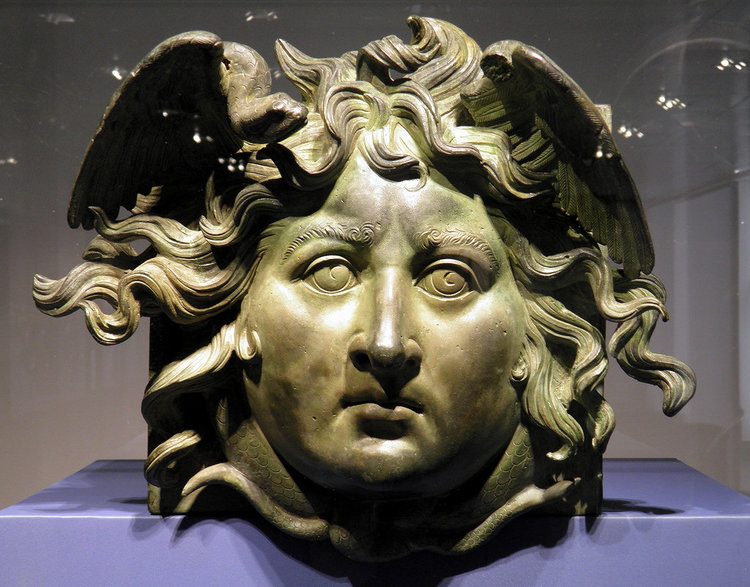
The Cressi Medusa Gigante Type B (below) came with twin built-in snorkels that may have suggested a passing resemblance to a pair of snakes projecting from the original Medusa's head. Featuring a chinpiece ("con sottomento"), and hence full-face coverage including the mouthm it was priced at 2000 lire:

And below are 1946 publicity images of a male and a female model wearing the Medusa Gigante Type B full-face snorkel-mask. The photograph illustrates how the mask fitted tightly under the chin and how it extended far back over the sides of the head, partially covering the ears as it did so:

Now that I've covered the minority of 1950s snorkel-masks with flexible hoses, I'm minded to continue with other spearfishing snorkel-masks of the same period. Earlier in this thread I posted the following image, captioning it "Amateur lobsterman holds up lobster he caught with net, Atlantic Ocean, near Maine":
The snorkel-mask worn by the "lobsterman" is a Cressi Medusa G 2. I am sure everybody knows all about Cressi, the Italian diving equipment manufacturer famous since the early 1950s for its low-volume Pinocchio mask and full-foot Rondine fins. The Cressi Medusa family of snorkel-masks is named after the ancient mythological monster Medusa (below) with serpent locks:
The Cressi Medusa Gigante Type B (below) came with twin built-in snorkels that may have suggested a passing resemblance to a pair of snakes projecting from the original Medusa's head. Featuring a chinpiece ("con sottomento"), and hence full-face coverage including the mouthm it was priced at 2000 lire:
And below are 1946 publicity images of a male and a female model wearing the Medusa Gigante Type B full-face snorkel-mask. The photograph illustrates how the mask fitted tightly under the chin and how it extended far back over the sides of the head, partially covering the ears as it did so:
The Cressi Medusa Gigante B was the predecessor of the lobsterman's snorkel-mask, which is a Cressi Medusa G Due:

The "G" classifies this snorkel-mask as a giant (Gigante) and/or full-face (Gran facciale) model, while the "Due", Italian for "two", indicates the presence of twin breathing tubes.
Our earliest source of information about the Medusa G Due is Cressi's 1953 catalogue:
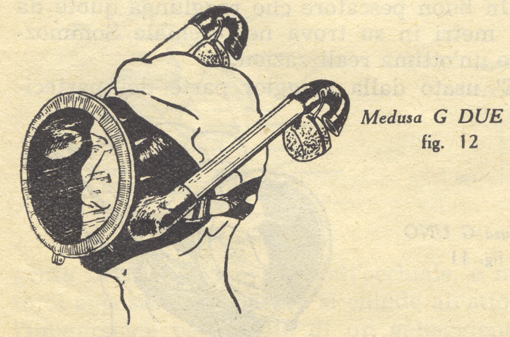
Italian: "Infine, chi si limita a stare alla superfice ad osservare il fondo marino, e vuole respirare dal naso e dalla bocca, può far uso (...) della MEDUSA DUE (con due respiratori) (Fig. 12). Questi tipi di occhiali racchiudono tutto il viso, compresa la bocca e il naso. Vengono costruiti in due misure: media e grande."
Rough translation: "Finally, those confined to remaining on the surface, observing the seabed and wishing to nose and mouth breathe can use (...) the MEDUSA DUE (with two breathing tubes) (Fig. 12). These types of goggles enclose the whole face, including the mouth and the nose. They are supplied in two sizes: Medium and Large."
Note the recommendation of the Medusa G Due for surface observation only and not for deeper diving, a probably necessary constraint in the absence of an ear-clearing facility. Note too the presence of a chinpiece (sottomento) at the bottom of the skirt to enclose the mouth as well as the eyes and the nose, enabling the wearer to breathe nasally or orally the air supplied through the twin snorkels when their hinge valves open at the surface of the water. And the availability of the mask in Medium and Large sizes to achieve a better, watertight fit for a variety of facial profiles.
The Medusa G Due reappeared thus in Cressi's 1955 catalogue. The caption says the twin-snorkel "Due" has the same features as the single-snorkel "Uno", so I've included information about the latter:

Italian: "Maschera a facciale completo; racchiude nell’interno tutto il viso. Massima aderenza e morbidezza dei bordi, ne fanno un’ottima maschera per l’osservazione. La respirazione è resa possibile da un opportuno organo incorporato (valvola). Indicata in tutti gli impieghi del genere e per immersioni limitate a pochi metri. In due misure: B (media), C (grande). MEDUSA G DUE. Ha le stesse caratteristiche della MEDUSA G UNO. E’ munita di due respiratori."
Official English translation: "Complete facial mask enclosing the whole face. Maximum adherence and softness of borders make this an excellent mask for observation. Respiration is permitted by the incorporated fixture of snorkels. Recommended for observation purposes and for immersions in shallow waters. Manufactured in three sizes: B (medium), C (large) and a special size for children. MEDUSA G DUE. This mask has the same characteristics as the Medusa G Uno but it is furnished with two incorporated snorkels."
My translation: "Full-face mask, enclosing whole face on inside. Edges have maximum grip and softness, making this an excellent mask for observation. A convenient integral device (valve) makes breathing possible. Suitable for all these kinds of uses and for diving with a depth limit of a few metres. Supplied in two fittings: B (Medium) or C (Large). MEDUSA G DUE. Has the same specifications as the MEDUSA G UNO. Fitted with two breathing tubes.
The 1955 catalogue drew a clear distinction between two classes of mask with built-in snorkels: "Maschere con valvola" and "Maschere a facciale". The former, "valve masks", provided eye and nose coverage only, while the latter, "full-face masks", enclosed the mouth too. Manifestlly, the Medusa G Due fell into Cressi's "maschere a facciale" category, where the presence of breathing tubes was implicit, because neither inhalation nor exhalation would have been possible without them.
Note the minor amendment to the mask's scope of usage — "suitable for diving with a depth limit of a few metres" — a concession doubtless designed to keep the spearfishing community on board.
The "G" classifies this snorkel-mask as a giant (Gigante) and/or full-face (Gran facciale) model, while the "Due", Italian for "two", indicates the presence of twin breathing tubes.
Our earliest source of information about the Medusa G Due is Cressi's 1953 catalogue:
Italian: "Infine, chi si limita a stare alla superfice ad osservare il fondo marino, e vuole respirare dal naso e dalla bocca, può far uso (...) della MEDUSA DUE (con due respiratori) (Fig. 12). Questi tipi di occhiali racchiudono tutto il viso, compresa la bocca e il naso. Vengono costruiti in due misure: media e grande."
Rough translation: "Finally, those confined to remaining on the surface, observing the seabed and wishing to nose and mouth breathe can use (...) the MEDUSA DUE (with two breathing tubes) (Fig. 12). These types of goggles enclose the whole face, including the mouth and the nose. They are supplied in two sizes: Medium and Large."
Note the recommendation of the Medusa G Due for surface observation only and not for deeper diving, a probably necessary constraint in the absence of an ear-clearing facility. Note too the presence of a chinpiece (sottomento) at the bottom of the skirt to enclose the mouth as well as the eyes and the nose, enabling the wearer to breathe nasally or orally the air supplied through the twin snorkels when their hinge valves open at the surface of the water. And the availability of the mask in Medium and Large sizes to achieve a better, watertight fit for a variety of facial profiles.
The Medusa G Due reappeared thus in Cressi's 1955 catalogue. The caption says the twin-snorkel "Due" has the same features as the single-snorkel "Uno", so I've included information about the latter:
Italian: "Maschera a facciale completo; racchiude nell’interno tutto il viso. Massima aderenza e morbidezza dei bordi, ne fanno un’ottima maschera per l’osservazione. La respirazione è resa possibile da un opportuno organo incorporato (valvola). Indicata in tutti gli impieghi del genere e per immersioni limitate a pochi metri. In due misure: B (media), C (grande). MEDUSA G DUE. Ha le stesse caratteristiche della MEDUSA G UNO. E’ munita di due respiratori."
Official English translation: "Complete facial mask enclosing the whole face. Maximum adherence and softness of borders make this an excellent mask for observation. Respiration is permitted by the incorporated fixture of snorkels. Recommended for observation purposes and for immersions in shallow waters. Manufactured in three sizes: B (medium), C (large) and a special size for children. MEDUSA G DUE. This mask has the same characteristics as the Medusa G Uno but it is furnished with two incorporated snorkels."
My translation: "Full-face mask, enclosing whole face on inside. Edges have maximum grip and softness, making this an excellent mask for observation. A convenient integral device (valve) makes breathing possible. Suitable for all these kinds of uses and for diving with a depth limit of a few metres. Supplied in two fittings: B (Medium) or C (Large). MEDUSA G DUE. Has the same specifications as the MEDUSA G UNO. Fitted with two breathing tubes.
The 1955 catalogue drew a clear distinction between two classes of mask with built-in snorkels: "Maschere con valvola" and "Maschere a facciale". The former, "valve masks", provided eye and nose coverage only, while the latter, "full-face masks", enclosed the mouth too. Manifestlly, the Medusa G Due fell into Cressi's "maschere a facciale" category, where the presence of breathing tubes was implicit, because neither inhalation nor exhalation would have been possible without them.
Note the minor amendment to the mask's scope of usage — "suitable for diving with a depth limit of a few metres" — a concession doubtless designed to keep the spearfishing community on board.
During the mid-1950s, the Medusa G Due appeared in several diving and spearfishing books.
Ivanovic's 1955 Modern Spearfishing:

The Carriers' 1955 Dive, although this book illustration represents the first-series version of the G 2, the Gigante B (note valves at surface end of snorkels):
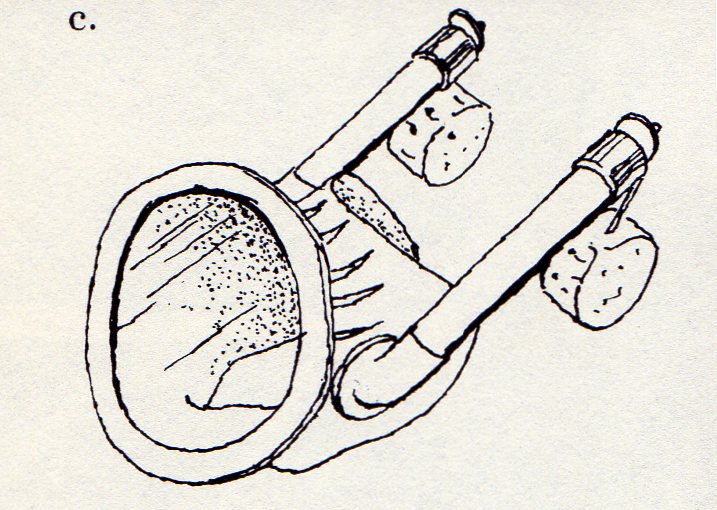
Vanderkogel's 1955 Underwater Sport:

Bronson-Howard's 1956 Handbook for skin divers:
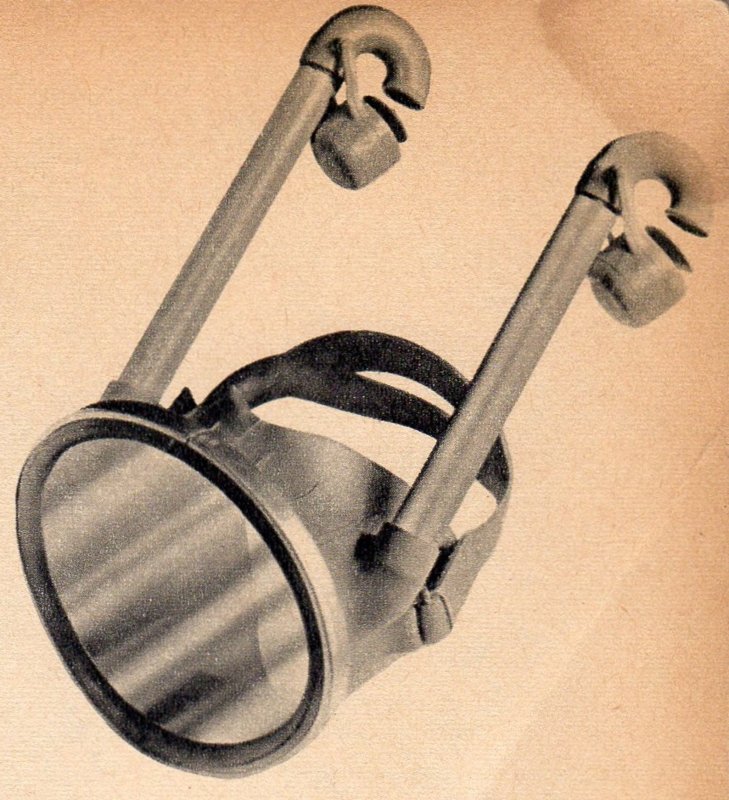
In Bronson-Howard's words: "While the majority of masks manufactured today are of standard design, the past three years has seen an increase in popularity for masks which feature built-in snorkel breathing tubes. Numerous models of French, Italian and American design are now on the market. These variations of the ordinary equipment are more expensive, but the added compactness and freedom they give the diver are well worth the difference in price. (Most amateurs, though, will do just as well with the standard models until they have completely mastered the underwater technique.) These masks come in one-breathing-tube and two-breathing-tube varieties. The one-tube model has a flexible rubber snorkel coming off the top center of the mask, or a rigid plastic tube coming off the side. The two-tuber has a plastic snorkel coming off each side of the mask, giving the diver a slightly Mephistophelean appearance when he sticks his head out of the water. The air-intake openings have either a hinged-cork arrangement or a ping-pong ball, which, due to its buoyancy, is forced up into the opening of the tube, thus closing it, when the swimmer is submerged. Unlike the standard mask, breathing is done with the nose, and the mouth is kept closed while the diver is lying face down on the surface of the water."
Small's 1957 Your guide to underwater adventure:
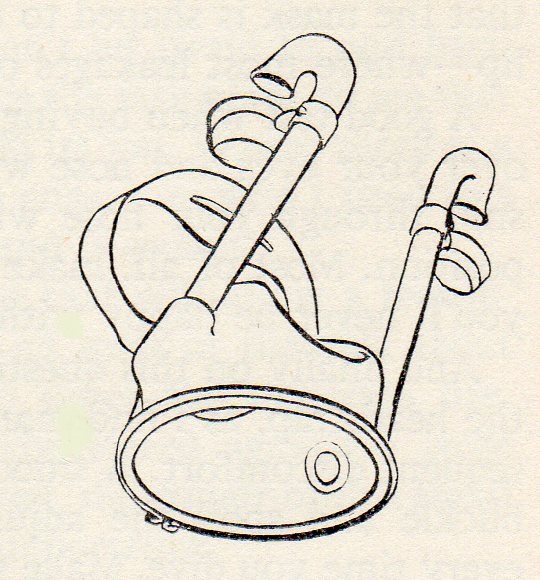
By the mid-1950s, the product was being exported outside Italy. Here are period ads for Cressi States-side:
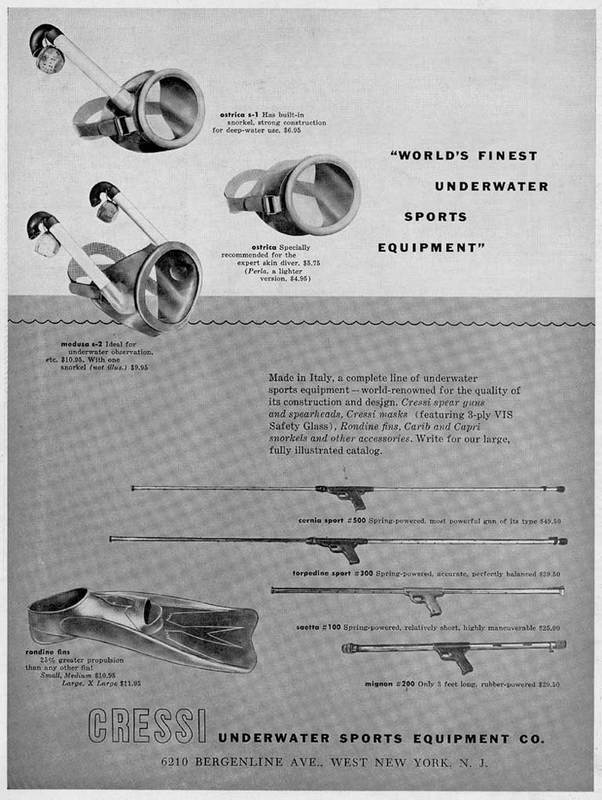
The Medusa G2 is the twin-snorkel mask in this publicity material.
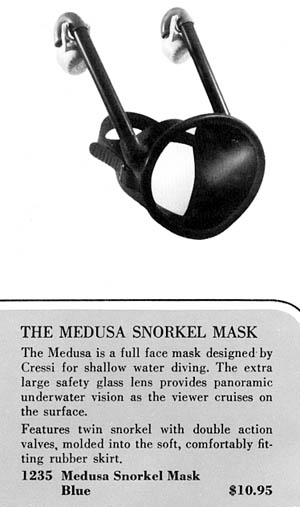
As for the UK, here's a page from the 1956 catalogue of the British manufacturer Typhoon, which carried some Cressi products:

and one from London-based Lillywhites' catalogue of the same year:
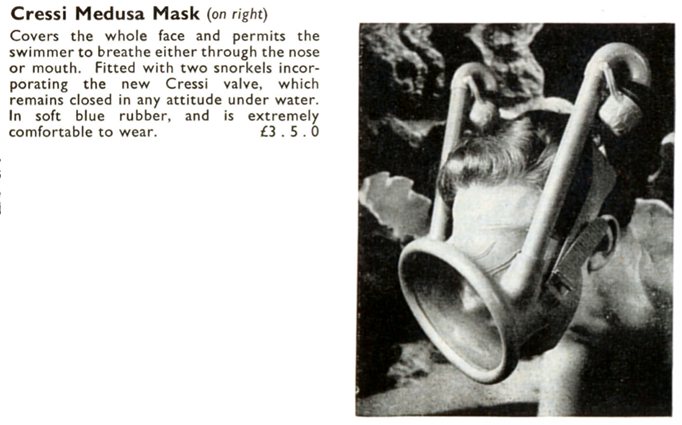
And back in Italy, here's the Medusa G2 in Cressi's 1959 catalogue:
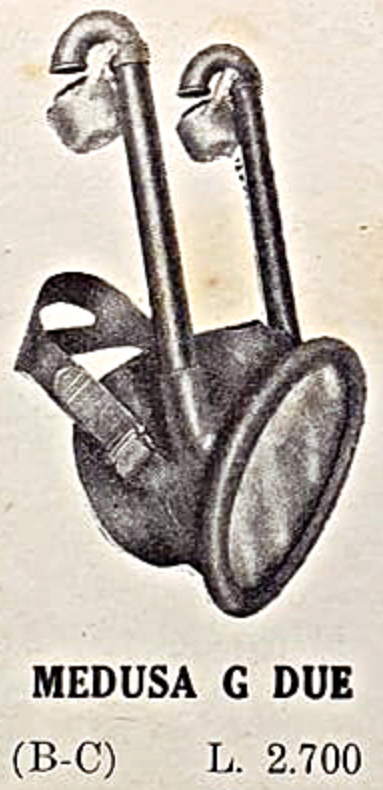
Note the continued availability of the G2 in Medium (B) and Large (C) fittings.
There is little doubt in my mind that the Cressi Medusa G2 gained an iconic status in its time, more perhaps than any other first-generation snorkel-mask. Although no snorkel-masks entered production in the USSR, Soviet diving manual authors were aware of their existence in the West:

Olga Shukova's underwater hunting book illustration above refers to the mask as a "«Двурогая» маска" ("bicorn" mask), a mask fitted with two horns. See it for yourself online at Снаряжение для охоты под водой.
By the way, this publication isn't the only book-length Russian diving title to be scanned and posted online to be viewed for free. Wouldn't it be nice, particularly in these COVID-19 times of goodwill to all men, if English-language diving journals and books shared their contents online too for everybody's benefit under lockdown?
But I digress. I included the Russian picture above to show (a) how widely known outside Italy the Medusa G2 was in its time and (b) the sinister impact the mask's appearance may have had on some contemporary observers. Shukova herself compares the Medusa G2's twin snorkels to the horns of a wild animal and counsels Russian spearfishers against using the mask if they ever manage to get hold of one. She captions the illustration "«Двурогая» маска — сложная и малопригодная в подводном спорте. Избегайте ее" (“Bicorn” mask: complicated and unsuitable for underwater sport. Avoid it.). So there.
The potential of Medusa G2 users to strike terror in non-snorkellers wasn't lost on western observers either. The 1958 British thriller film "The Snorkel" appears to feature a Medusa G2 as the villain's principal prop:
And here is an American newspaper article from March 1957:
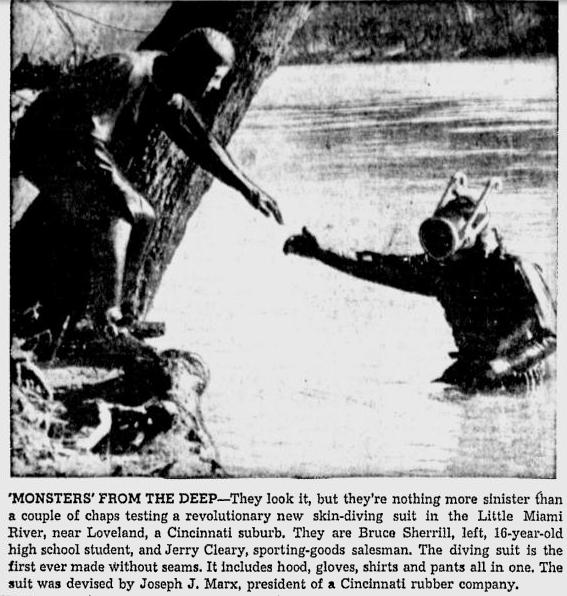
So what the good citizens of Loveland, Ohio, were witnessing did not turn out to be the Little Miami River's very own Loch Ness Monster after all, but simply a couple of young men testing prototypes of the future Skooba-"totes" dry suit manufactured in the So-Lo Marx Rubber works nearby.
The scene above was recreated for a 1959 advertisement:
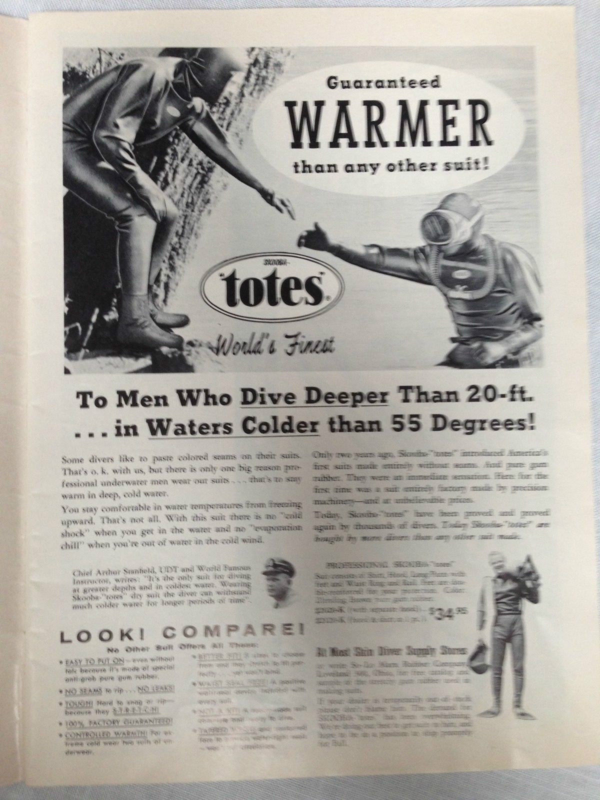
Note how the figure standing in the stream with the twin-snorkel mask over his eyes, nose and mouth in 1957 has replaced this headgear with a conventional half-mask and double-hose regulator in 1959.
Ivanovic's 1955 Modern Spearfishing:
The Carriers' 1955 Dive, although this book illustration represents the first-series version of the G 2, the Gigante B (note valves at surface end of snorkels):
Vanderkogel's 1955 Underwater Sport:
Bronson-Howard's 1956 Handbook for skin divers:
In Bronson-Howard's words: "While the majority of masks manufactured today are of standard design, the past three years has seen an increase in popularity for masks which feature built-in snorkel breathing tubes. Numerous models of French, Italian and American design are now on the market. These variations of the ordinary equipment are more expensive, but the added compactness and freedom they give the diver are well worth the difference in price. (Most amateurs, though, will do just as well with the standard models until they have completely mastered the underwater technique.) These masks come in one-breathing-tube and two-breathing-tube varieties. The one-tube model has a flexible rubber snorkel coming off the top center of the mask, or a rigid plastic tube coming off the side. The two-tuber has a plastic snorkel coming off each side of the mask, giving the diver a slightly Mephistophelean appearance when he sticks his head out of the water. The air-intake openings have either a hinged-cork arrangement or a ping-pong ball, which, due to its buoyancy, is forced up into the opening of the tube, thus closing it, when the swimmer is submerged. Unlike the standard mask, breathing is done with the nose, and the mouth is kept closed while the diver is lying face down on the surface of the water."
Small's 1957 Your guide to underwater adventure:
By the mid-1950s, the product was being exported outside Italy. Here are period ads for Cressi States-side:
The Medusa G2 is the twin-snorkel mask in this publicity material.
As for the UK, here's a page from the 1956 catalogue of the British manufacturer Typhoon, which carried some Cressi products:
and one from London-based Lillywhites' catalogue of the same year:
And back in Italy, here's the Medusa G2 in Cressi's 1959 catalogue:
Note the continued availability of the G2 in Medium (B) and Large (C) fittings.
There is little doubt in my mind that the Cressi Medusa G2 gained an iconic status in its time, more perhaps than any other first-generation snorkel-mask. Although no snorkel-masks entered production in the USSR, Soviet diving manual authors were aware of their existence in the West:
Olga Shukova's underwater hunting book illustration above refers to the mask as a "«Двурогая» маска" ("bicorn" mask), a mask fitted with two horns. See it for yourself online at Снаряжение для охоты под водой.
By the way, this publication isn't the only book-length Russian diving title to be scanned and posted online to be viewed for free. Wouldn't it be nice, particularly in these COVID-19 times of goodwill to all men, if English-language diving journals and books shared their contents online too for everybody's benefit under lockdown?
But I digress. I included the Russian picture above to show (a) how widely known outside Italy the Medusa G2 was in its time and (b) the sinister impact the mask's appearance may have had on some contemporary observers. Shukova herself compares the Medusa G2's twin snorkels to the horns of a wild animal and counsels Russian spearfishers against using the mask if they ever manage to get hold of one. She captions the illustration "«Двурогая» маска — сложная и малопригодная в подводном спорте. Избегайте ее" (“Bicorn” mask: complicated and unsuitable for underwater sport. Avoid it.). So there.
The potential of Medusa G2 users to strike terror in non-snorkellers wasn't lost on western observers either. The 1958 British thriller film "The Snorkel" appears to feature a Medusa G2 as the villain's principal prop:
And here is an American newspaper article from March 1957:
So what the good citizens of Loveland, Ohio, were witnessing did not turn out to be the Little Miami River's very own Loch Ness Monster after all, but simply a couple of young men testing prototypes of the future Skooba-"totes" dry suit manufactured in the So-Lo Marx Rubber works nearby.
The scene above was recreated for a 1959 advertisement:
Note how the figure standing in the stream with the twin-snorkel mask over his eyes, nose and mouth in 1957 has replaced this headgear with a conventional half-mask and double-hose regulator in 1959.
Now for the more positive, or at least lighthearted, images I promised for the Cressi Medusa G2 snorkel-mask. I'm grouping them together by common factors other than date.
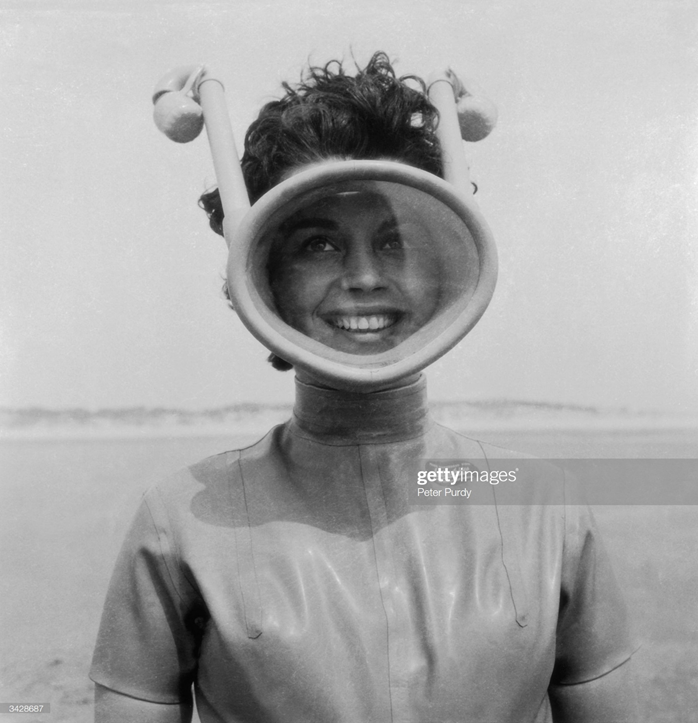
Frogwoman
1955: A woman equipped for a diving session with an unusual full face mask with integrated snorkels and wetsuit. (Photo by Peter Purdy/BIPs/Getty Images)
A woman equipped for a diving session with an unusual full face mask... News Photo - Getty Images
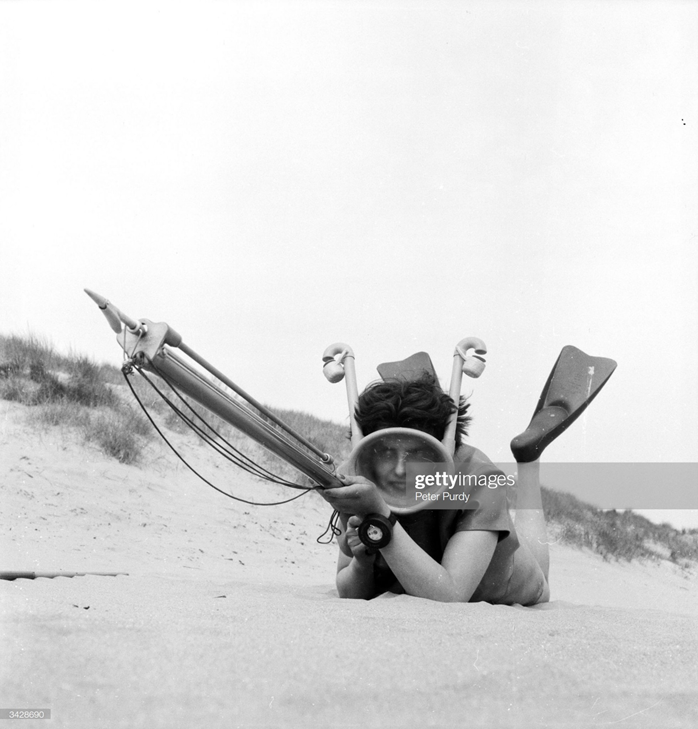
Harpoon Gun
1955: A woman equipped for a diving session, complete with an unusual full face mask with integrated snorkels, fins and harpoon gun. (Photo by Peter Purdy/BIPs/Getty Images)
A woman equipped for a diving session, complete with an unusual full... News Photo - Getty Images
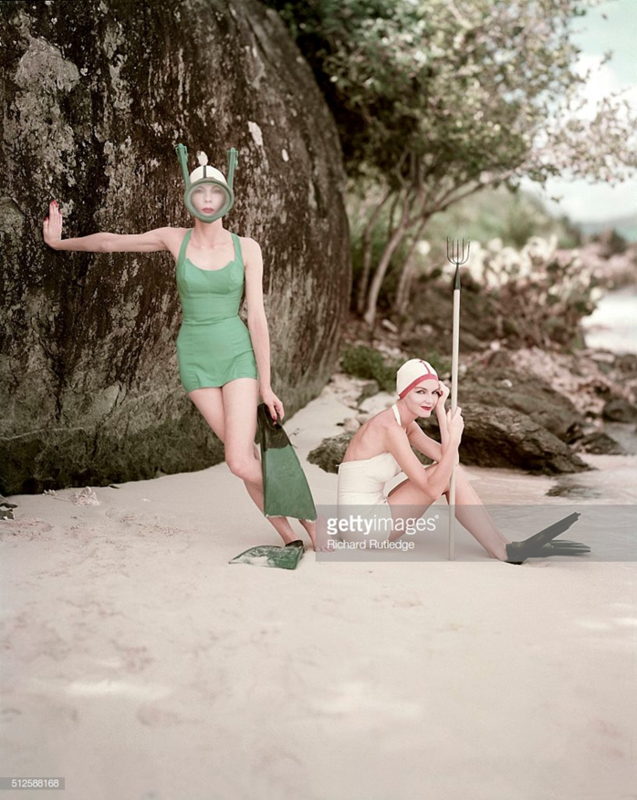
Vogue 1957
Two models in Rose Marie Reid swimsuits on the US Virgin Islands. Model on left stands tree wearing blue suit, mask and flippers; model on right wears white suit with matching cap, and flippers. (Photo by Richard Rutledge/Condé Nast via Getty Images)
Two models in Rose Marie Reid swimsuits on the US Virgin Islands.... News Photo - Getty Images
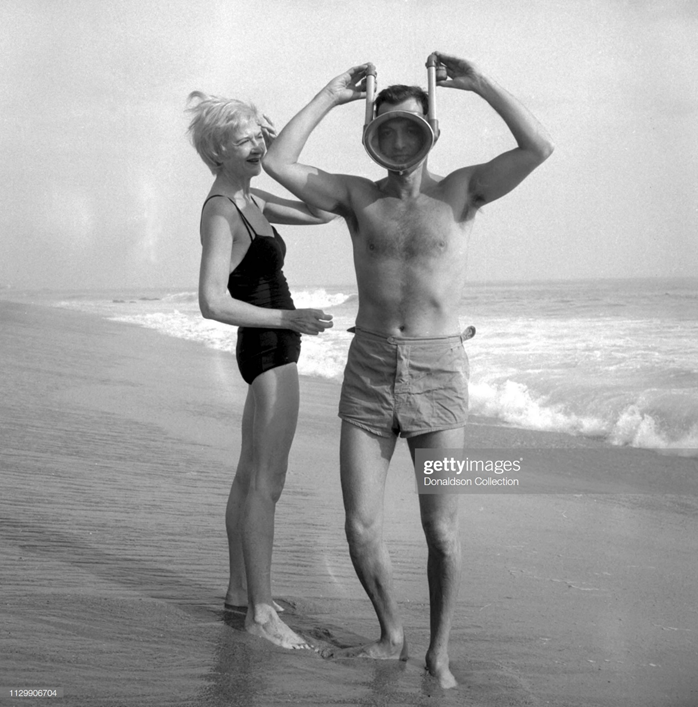
Tony Randall and Florence Gibbs
1959: Actor Tony Randall and his wife Florence Gibbs goof around on the beach with a snorkel mask in 1959. (Photo by Richard C. Miller/Donaldson Collection/Getty Images)
Actor Tony Randall and his wife Florence Gibbs goof around on the... News Photo - Getty Images
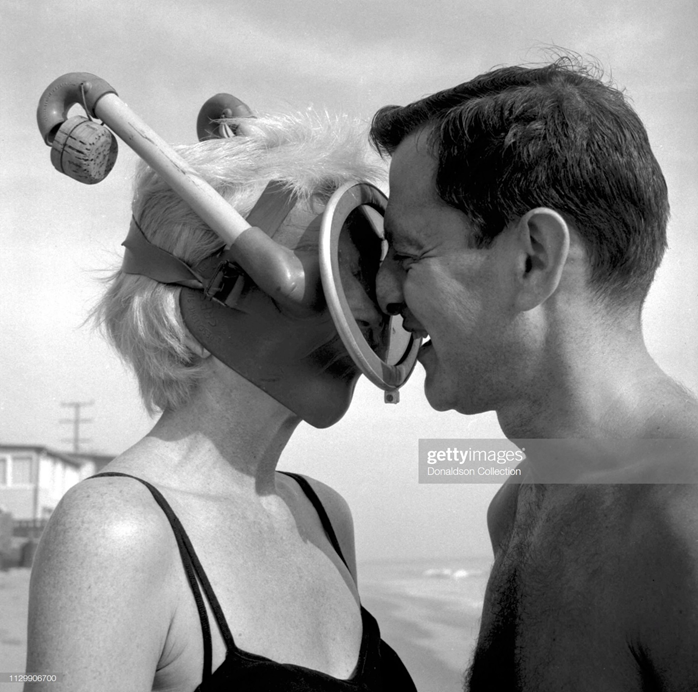
Tony Randall and Florence Gibbs
1959: Actor Tony Randall and his wife Florence Gibbs goof around on the beach with a snorkel mask in 1959. (Photo by Richard C. Miller/Donaldson Collection/Getty Images)
Actor Tony Randall and his wife Florence Gibbs goof around on the... News Photo - Getty Images
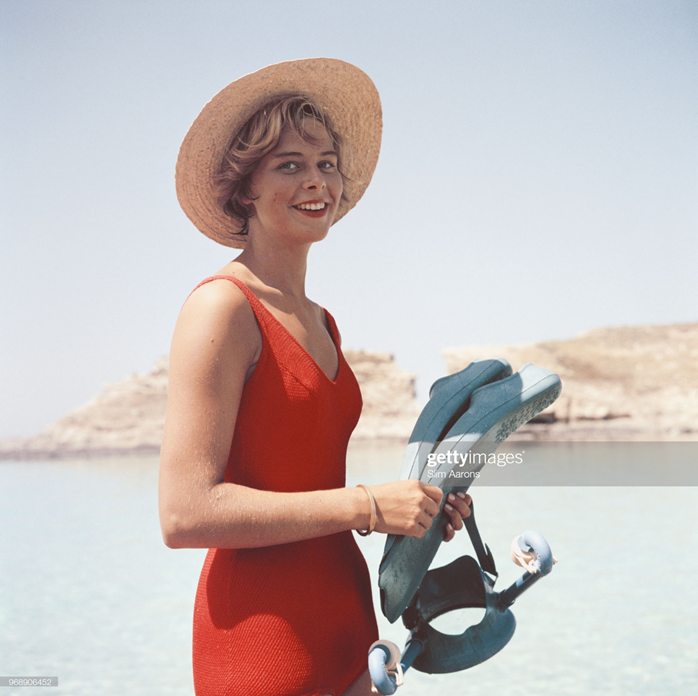
Marietine Birnie
1959: Marietine Birnie snorkelling at the Blue Lagoon, Kemmuna (Comina), Malta, July 1959. (Photo by Slim Aarons/Hulton Archive/Getty Images)
Marietine Birnie snorkeling at the Blue Lagoon, Kemmuna , Malta, July... News Photo - Getty Images
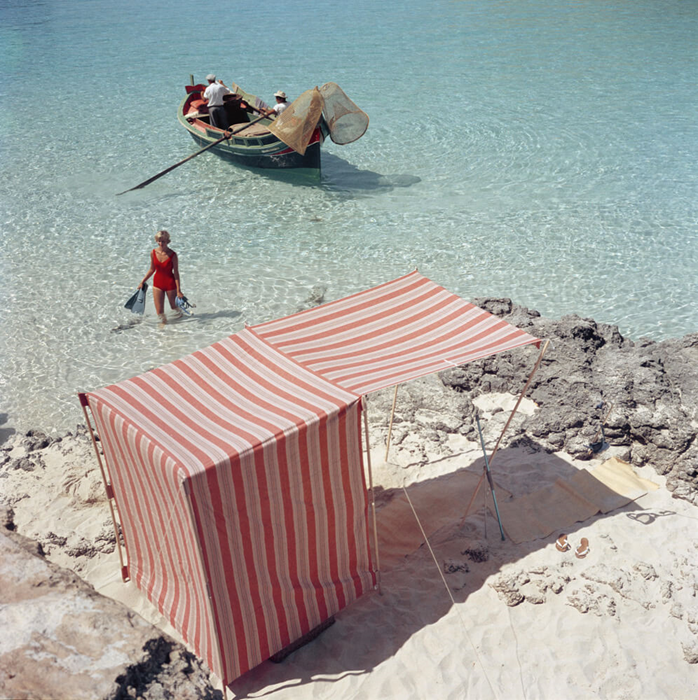
Marietine Birnie, Blue Lagoon
Marietine Birnie snorkeling at the Blue Lagoon, Kemmuna (Comina), Malta, July 1959. (Photo by Slim Aarons/Hulton Archive/Getty Images)
Marietine Birnie snorkeling at the Blue Lagoon, Kemmuna , Malta, July... News Photo - Getty Images

Montego bay, Jamaica
October 1958: Maggie in snorkelling gear. From the third of three small “ektachrome transparencies” boxes, this set (labelled “personal fair great / our wedding”) of film positives includes wedding photographs of nick's wife, Maggie Dewolf, and a very young son, alexander Dewolf; also images from various trips, and of Boston’s beacon hill neighbourhood. Part of an archival project, featuring the photographs of Nick Dewolf.
https://live.staticflickr.com/8112/8557900870_bfa7585270_b.jpg
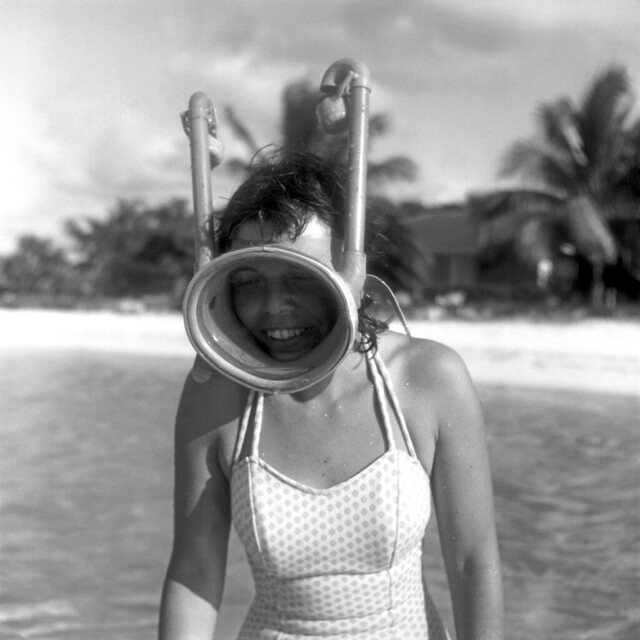
Montego bay, Jamaica
October 1958: Maggie in snorkelling gear. Part of an archival project, featuring the photographs of Nick Dewolf
https://live.staticflickr.com/3172/2346020138_7f744d6a97_z.jpg
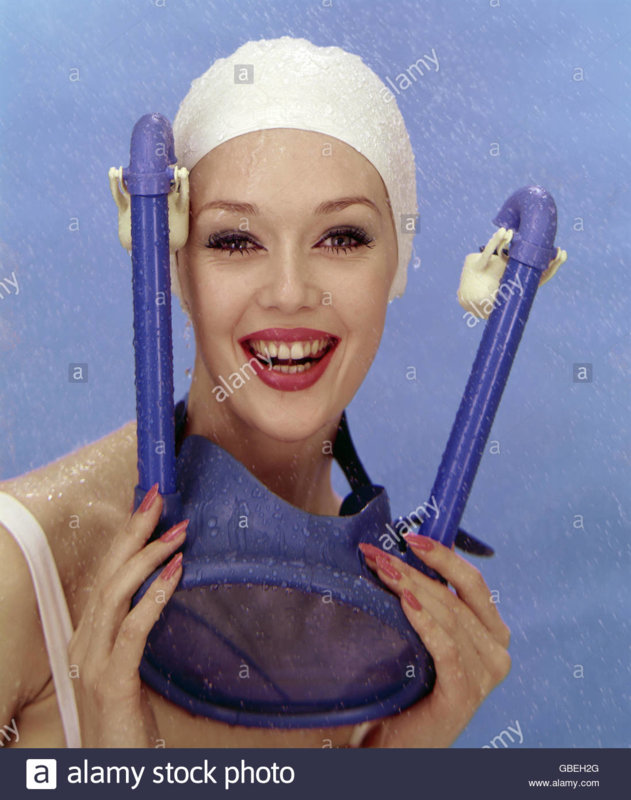
Woman with bathing cap, diving goggles and snorkel, studio shot, 1960s
Stock Photo - leisure time, sports, water sports, diving, woman with bathing cap, diving goggles and snorkel, studio shot, 1960s, , Additional-Rights-Clearences-NA
We'll have a look at another prominent snorkel-mask next time.
Frogwoman
1955: A woman equipped for a diving session with an unusual full face mask with integrated snorkels and wetsuit. (Photo by Peter Purdy/BIPs/Getty Images)
A woman equipped for a diving session with an unusual full face mask... News Photo - Getty Images
Harpoon Gun
1955: A woman equipped for a diving session, complete with an unusual full face mask with integrated snorkels, fins and harpoon gun. (Photo by Peter Purdy/BIPs/Getty Images)
A woman equipped for a diving session, complete with an unusual full... News Photo - Getty Images
Vogue 1957
Two models in Rose Marie Reid swimsuits on the US Virgin Islands. Model on left stands tree wearing blue suit, mask and flippers; model on right wears white suit with matching cap, and flippers. (Photo by Richard Rutledge/Condé Nast via Getty Images)
Two models in Rose Marie Reid swimsuits on the US Virgin Islands.... News Photo - Getty Images
Tony Randall and Florence Gibbs
1959: Actor Tony Randall and his wife Florence Gibbs goof around on the beach with a snorkel mask in 1959. (Photo by Richard C. Miller/Donaldson Collection/Getty Images)
Actor Tony Randall and his wife Florence Gibbs goof around on the... News Photo - Getty Images
Tony Randall and Florence Gibbs
1959: Actor Tony Randall and his wife Florence Gibbs goof around on the beach with a snorkel mask in 1959. (Photo by Richard C. Miller/Donaldson Collection/Getty Images)
Actor Tony Randall and his wife Florence Gibbs goof around on the... News Photo - Getty Images
Marietine Birnie
1959: Marietine Birnie snorkelling at the Blue Lagoon, Kemmuna (Comina), Malta, July 1959. (Photo by Slim Aarons/Hulton Archive/Getty Images)
Marietine Birnie snorkeling at the Blue Lagoon, Kemmuna , Malta, July... News Photo - Getty Images
Marietine Birnie, Blue Lagoon
Marietine Birnie snorkeling at the Blue Lagoon, Kemmuna (Comina), Malta, July 1959. (Photo by Slim Aarons/Hulton Archive/Getty Images)
Marietine Birnie snorkeling at the Blue Lagoon, Kemmuna , Malta, July... News Photo - Getty Images
Montego bay, Jamaica
October 1958: Maggie in snorkelling gear. From the third of three small “ektachrome transparencies” boxes, this set (labelled “personal fair great / our wedding”) of film positives includes wedding photographs of nick's wife, Maggie Dewolf, and a very young son, alexander Dewolf; also images from various trips, and of Boston’s beacon hill neighbourhood. Part of an archival project, featuring the photographs of Nick Dewolf.
https://live.staticflickr.com/8112/8557900870_bfa7585270_b.jpg
Montego bay, Jamaica
October 1958: Maggie in snorkelling gear. Part of an archival project, featuring the photographs of Nick Dewolf
https://live.staticflickr.com/3172/2346020138_7f744d6a97_z.jpg
Woman with bathing cap, diving goggles and snorkel, studio shot, 1960s
Stock Photo - leisure time, sports, water sports, diving, woman with bathing cap, diving goggles and snorkel, studio shot, 1960s, , Additional-Rights-Clearences-NA
We'll have a look at another prominent snorkel-mask next time.
Time methinks to look at the Pirelli Nereide snorkel-mask, which was favoured by a number of underwater hunters during the 1950s:

Spear Fishing Snorkelers in the Water

Illustration from Lumière's Beneath the seven seas.
Here it is, illustrated and captioned on page 134 of Hilbert Schenck Jr. and Henry Kendall's Shallow Water Diving and Spearfishing (Cambridge, Maryland: Cornell Maritime Press, 1954):

Page 140 of this seminal work has more: "Several swimmers have taken standard masks and permanently affixed tubes to them, but this means that all breathing is done through the nose, which is tiring as well as conducive to bad swimming habits. A rather interesting mask-snorkel combination is shown in Figure 56. This Pirelli equipment is probably the most elaborate and expensive mask on the market. Instead of using a ping-pong ball to close the tube in rough water, Pirelli uses a cork float arrangement which is more rugged and permanent than the ball. Unlike other masks this one covers the mouth as well as the nose and eyes. The swimmer thus has to depend on the snorkel at all times, and must expel any water that gets into the mask through it. This mask also has a compensating chamber at the back of the head to equalize pressure inside and outside the mask on deep dives. This rig was greeted with mixed emotions, and is probably not suitable for any but experienced gogglers who can spend an hour or so without needing to take the mask off.
The quotation above mentions the Pirelli Nereide's high price tag. Here is an excerpt from the 1955 mail-order catalogue of London's premier sporting goods store Lillywhites:

Back in 1955, £7 2s 6d would have resembled a king's ransom.
The Nereide soon parted with its "compensating chamber at the back of the head to equalize pressure inside and outside the mask on deep dives", resulting in a generous price reduction in 1958 to £3 16s 6d:

Spear Fishing Snorkelers in the Water
Illustration from Lumière's Beneath the seven seas.
Here it is, illustrated and captioned on page 134 of Hilbert Schenck Jr. and Henry Kendall's Shallow Water Diving and Spearfishing (Cambridge, Maryland: Cornell Maritime Press, 1954):
Page 140 of this seminal work has more: "Several swimmers have taken standard masks and permanently affixed tubes to them, but this means that all breathing is done through the nose, which is tiring as well as conducive to bad swimming habits. A rather interesting mask-snorkel combination is shown in Figure 56. This Pirelli equipment is probably the most elaborate and expensive mask on the market. Instead of using a ping-pong ball to close the tube in rough water, Pirelli uses a cork float arrangement which is more rugged and permanent than the ball. Unlike other masks this one covers the mouth as well as the nose and eyes. The swimmer thus has to depend on the snorkel at all times, and must expel any water that gets into the mask through it. This mask also has a compensating chamber at the back of the head to equalize pressure inside and outside the mask on deep dives. This rig was greeted with mixed emotions, and is probably not suitable for any but experienced gogglers who can spend an hour or so without needing to take the mask off.
The quotation above mentions the Pirelli Nereide's high price tag. Here is an excerpt from the 1955 mail-order catalogue of London's premier sporting goods store Lillywhites:
Back in 1955, £7 2s 6d would have resembled a king's ransom.
The Nereide soon parted with its "compensating chamber at the back of the head to equalize pressure inside and outside the mask on deep dives", resulting in a generous price reduction in 1958 to £3 16s 6d:
The Pirelli Nereide even made its mark in the Soviet Union. In 1959, Ольга Жукова (Ol’ga Zhukova) published a spearfishing book there enitled Подводная Охота (Underwater Hunting), whose full text can be found online at http://oldmemory.ru/?file=podvodnaya-ohota:


Her verdict on the mask, however, was: "Маска «единорог», неудобная для охоты и ныряния", which roughly translates to "'Unicorn' mask, neither hunting- nor diving-friendly." Not a fan, then, but few citizens of the USSR would have had an opportunity anyway to try out for themselves a piece of western diving equipment.
The Nereide snorkel-mask remained in Pirelli's diving equipment catalogues until 1968, so the product enjoyed quite a long service life. Here, finally, is a picture of the mask in all its full-colour glory with a close-up of its markings to follow:


The Pirelli Nereide is now an exhibit to be viewed in online museums such as https://blutimescubahistory.com/?q=...iche/maschere/pirelli/scheda-completa/nereide and https://www.museosubacqueotorinese.com/gestione zoom/multizoom_maschere.php?cod=7&collezione=Maschere&sottocollezione=&cartellafoto=maschere&nomefoto=pirellirosso&nomemacchina=Pirelli&nrtumb=1. Sic transit gloria mundi.
I'll review another prominent item of 1950s underwater hunting gear in my next posting.
Her verdict on the mask, however, was: "Маска «единорог», неудобная для охоты и ныряния", which roughly translates to "'Unicorn' mask, neither hunting- nor diving-friendly." Not a fan, then, but few citizens of the USSR would have had an opportunity anyway to try out for themselves a piece of western diving equipment.
The Nereide snorkel-mask remained in Pirelli's diving equipment catalogues until 1968, so the product enjoyed quite a long service life. Here, finally, is a picture of the mask in all its full-colour glory with a close-up of its markings to follow:
The Pirelli Nereide is now an exhibit to be viewed in online museums such as https://blutimescubahistory.com/?q=...iche/maschere/pirelli/scheda-completa/nereide and https://www.museosubacqueotorinese.com/gestione zoom/multizoom_maschere.php?cod=7&collezione=Maschere&sottocollezione=&cartellafoto=maschere&nomefoto=pirellirosso&nomemacchina=Pirelli&nrtumb=1. Sic transit gloria mundi.
I'll review another prominent item of 1950s underwater hunting gear in my next posting.


